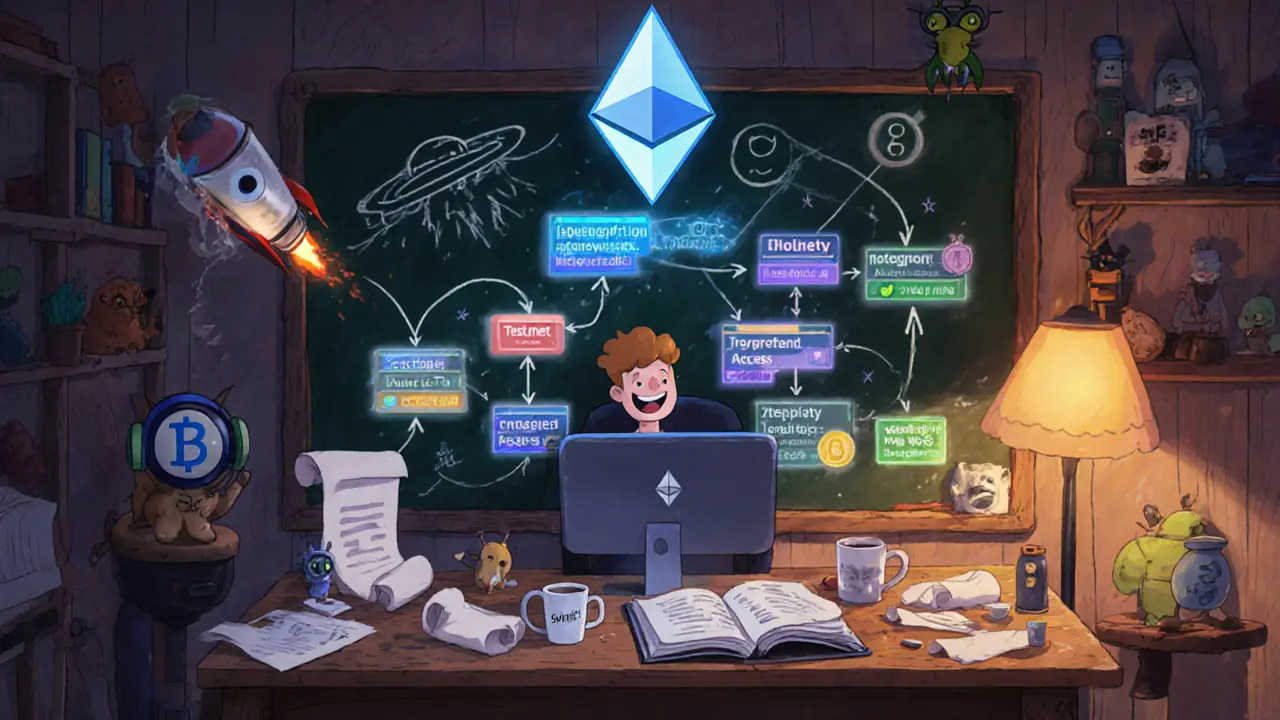Content Monetization Model Calculator
Typical Use-case: Monthly access to video libraries, podcasts, premium newsletters
- Recurring automated payouts
- Easy revenue forecasting
- Gas fees for each renewal can add up
- Churn tracking requires off-chain analytics
Typical Use-case: Pay-per-article, per-song, or per-tool usage
- Zero-friction for casual users
- Captures value from high-traffic sites
- Very small amounts can be eclipsed by transaction costs
- Requires layer-2 solutions for efficiency
Typical Use-case: Sell NFT tickets, virtual-world land parcels, or exclusive digital art
- Proof of ownership
- Secondary-market royalties
- Community governance
- Market volatility
- Need for wallet onboarding
Typical Use-case: Creators lock a portion of token supply to earn interest, then share yields with fans
- Passive income streams
- Aligns creator-audience incentives
- Complex risk profile
- Smart-contract bugs can lead to loss of funds
Imagine getting paid the moment a fan streams your video, reads an article, or buys a virtual artwork-without waiting for a middleman to slice the fee. Content monetization by way of smart contracts makes that vision a reality, turning every interaction into an instant, transparent settlement on a blockchain.
What Are Content Monetization Smart Contracts?
Content monetization smart contracts are automated, self‑executing agreements that live on a blockchain. When predefined conditions-like a user completing a payment or reaching a view count-are met, the contract instantly distributes royalties, subscription fees, or token rewards to the rightful parties. No manual invoicing, no hidden delays, and every transaction is recorded in an immutable ledger.
Why Blockchain Matters
The backbone of these contracts is the Ethereum network, the most widely adopted platform for deploying decentralized applications. Ethereum’s public, permission‑less nature guarantees that once a contract is live, anyone can verify its code and outcomes, building trust between creators and consumers. While newer chains like Solana or Polygon offer cheaper fees, Ethereum still dominates because of its mature tooling and massive developer community.
Building Blocks: The Core Technologies
To write a functional contract, developers usually turn to Solidity, the high‑level language designed for Ethereum Virtual Machine (EVM) execution. Solidity lets you define the “if‑then” logic, set payment addresses, and trigger events that external apps can listen to. For developers preferring Rust or Vyper, the same concepts apply-just a different syntax.

Key Revenue Models Powered by Smart Contracts
Smart contracts support a range of monetization strategies. Below is a quick snapshot of the most common approaches, their typical use‑cases, and the pros/cons you’ll face on‑chain.
| Model | Typical Use‑Case | On‑Chain Benefits | Challenges |
|---|---|---|---|
| Subscription | Monthly access to video libraries, podcasts, premium newsletters | Recurring automated payouts; easy revenue forecasting | Gas fees for each renewal can add up; churn tracking requires off‑chain analytics |
| Micropayments | Pay‑per‑article, per‑song, or per‑tool usage | Zero‑friction for casual users; captures value from high‑traffic sites | Very small amounts can be eclipsed by transaction costs unless using layer‑2 solutions |
| Tokenized Access | Sell NFT tickets, virtual‑world land parcels, or exclusive digital art | Proof of ownership, secondary‑market royalties, community governance | Market volatility; need for wallet onboarding |
| DeFi Staking / Yield Farming | Creators lock a portion of token supply to earn interest, then share yields with fans | Passive income streams; aligns creator‑audience incentives | Complex risk profile; smart‑contract bugs can lead to loss of funds |
Step‑By‑Step: Deploying Your First Monetization Contract
- Define the revenue logic. Write down every condition that should trigger a payment-e.g., “When user X purchases token Y, transfer 0.01ETH to creator address.”
- Choose a programming language. Most creators start with Solidity because of its extensive libraries (OpenZeppelin, ERC‑20/721 standards).
- Write and test locally. Use Remix IDE or Hardhat to simulate transactions. Verify that edge cases-like refunds or failed payments-behave as expected.
- Deploy to a testnet. Deploy on Sepolia or Goerli first. This lets you see real gas costs and user experience without risking real funds.
- Integrate with your platform. Connect the contract’s public ABI to your website or app via Web3.js or Ethers.js. Provide a “Connect Wallet” button so users can sign transactions.
- If you’re using a subscription model, set up recurring on‑chain payments using ERC‑2535 proxy patterns.
- For micropayments, consider a layer‑2 like Polygon to keep fees under $0.01 per click.
- Launch and monitor. After going live, watch the blockchain explorer for transaction failures. Use tools like The Graph to index events for off‑chain dashboards.
Real‑World Examples That Made It Work
1. AudioVerse-a podcaster network tokenized each episode as an ERC‑721 NFT. Listeners bought the NFT, which granted a 30‑day listening window and automatically sent 5% royalties to guest speakers on every resale.
2. PixelPress-a news site integrated a Micropay‑Per‑Article contract on Polygon. Readers spent 0.0005MATIC per paragraph; the contract split 70% to the writer, 20% to the platform, and 10% to a charity wallet.
3. VRWorld-offered VR experiences via tokenized tickets. Each ticket was a time‑locked ERC‑1155 token that unlocked a 15‑minute immersive session. After the session, the contract automatically refunded unused time as a new token.

Benefits That Matter to Creators
- Instant settlement. No waiting for monthly invoices; cash flow improves dramatically.
- Transparent royalty tracking. Every payment is publicly verifiable, eliminating disputes.
- Global reach. Cryptocurrency works across borders without conversion fees.
- Programmable incentives. Offer loyalty bonuses, early‑bird discounts, or fan‑governed revenue shares directly in code.
Potential Pitfalls and How to Avoid Them
- Gas fee volatility. During network congestion, a $0.02 micropayment can become $0.20. Mitigate by using layer‑2 solutions or batching payments.
- Scalability limits. Public blockchains process ~15TPS on Ethereum mainnet. For high‑traffic platforms, consider sidechains or rollups.
- User onboarding. Not everyone has a crypto wallet. Provide a simple hosted wallet option or integrate with services like Magic.link.
- Regulatory uncertainty. Some jurisdictions treat token sales as securities. Conduct a legal review and consider KYC/AML procedures if needed.
Future Trends to Watch
Tokenized revenue streams are evolving beyond simple NFTs. Expect “fractional ownership” tokens that let fans buy a 0.1% share of a creator’s future earnings, with smart contracts automatically distributing royalties. At the same time, DeFi protocols are experimenting with “content yield farms,” where creators stake their tokenized assets to earn extra yield that can be redistributed to their community.
Artificial intelligence will also play a role: predictive analytics can feed on‑chain data to fine‑tune pricing, recommend subscription tiers, or identify which pieces are ripe for micro‑pricing. As the tech stack matures, the line between traditional media and decentralized finance will blur even more.
Frequently Asked Questions
Can I use smart contracts without knowing how to code?
Yes. Platforms like Superfluid, Zora, or Mintgate offer no‑code interfaces that let you configure royalty splits and subscription logic, then automatically generate the underlying Solidity contract for you.
What’s the cheapest way to handle micropayments?
Layer‑2 networks (Polygon, Arbitrum, Optimism) reduce fees to fractions of a cent. You can also batch multiple user actions into a single on‑chain transaction to spread the cost.
Do I have to launch my own token?
Not always. You can piggyback on existing standards like ERC‑20 for currency or ERC‑721 for access passes. Some creators simply accept stablecoins (USDC, DAI) to avoid volatility.
How do I protect my contract from hacks?
Use audited libraries (OpenZeppelin), run formal verification tools (MythX, Slither), and perform a third‑party audit before mainnet deployment. Also, add a pause function to stop activity if a vulnerability is discovered.
Will my fans need to understand crypto to use my service?
Ideally no. Offer custodial wallets or integrated payment gateways that abstract away the blockchain details, letting users pay with credit cards while the backend converts to crypto.


Comments
Promise Usoh
When we contemplate the rise of on‑chain monetization, we are really looking at the philosophy of value itself.
It is not merely a technical shift, but a redefinition of what it means to be compensated for creative labor.
Traditional gatekeepers have long dictated the flow of revenue, shaping ecosystems around scarcity and control.
The blockchain, by contrast, offers a distributed ledger that records each interaction with immutable clarity.
This transparency forces creators to reckon with the true worth of each view, click, or listen.
Imagine a world where a single micro‑payment is not eroded by administrative overhead, but arrives whole to the artist's wallet.
Such immediacy challenges the old notion that only large aggregators can profit from small contributions.
Moreover, the programmable nature of smart contracts embeds royalty splits directly into the transaction, removing the need for after‑the‑fact negotiations.
From a philosophical standpoint, we see a movement toward decentralised autonomy, where power is redistributed from platforms to individuals.
At the same time, the volatility of gas fees introduces a new form of friction, one that demands economic literacy from creators.
Yet this very friction invites innovation: layer‑2 solutions, batch payments, and meta‑transactions act as lubricants in the system.
The interplay between on‑chain certainty and off‑chain analytics creates a hybrid reality that is both complex and fertile.
In essence, the smart contract becomes a digital contract of trust, enforced by code rather than human arbitration.
As we continue to adopt these mechanisms, we must ask not just how much we can earn, but how the very concept of earning evolves in a trustless environment.
Only then can we truly claim that technology has empowered the creator beyond the limits of traditional economics.
October 6, 2025 AT 09:02
Shaian Rawlins
I love seeing how these tools open doors for creators who might not have had a voice before.
When you break down the barriers of payment processing, you’re basically handing power back to the people who actually make the content.
Think about a small indie podcaster who can now earn a steady stream from listeners without waiting weeks for a payout.
The instant settlement model feels like a breath of fresh air in an industry that’s been clogged with middlemen for decades.
Also, the fact that you can layer‑2 solutions to cut gas costs means the model becomes scalable for even massive audiences.
It’s not just about making money; it’s about building sustainable relationships between creators and fans.
Every interaction becomes a tangible exchange, which can strengthen community loyalty over time.
And because the contracts are transparent, there’s less room for hidden fees or shady royalty splits that have plagued the music and publishing worlds.
All of this together signals a real paradigm shift toward more equitable economics for digital creators.
Keep pushing these innovations, and we’ll see a whole new era of independent content flourishing worldwide.
October 10, 2025 AT 06:02
Tyrone Tubero
Well, look at this, another "revolution" in the endless sea of hype.
Smart contracts are the new buzzword everyone throws around like confetti at a parade.
Sure, the idea of instant payouts sounds shiny, but have you actually considered the hidden complexity?
Deploying Solidity code is like playing with fire-one tiny bug and the whole vault could be empty.
And don’t get me started on gas fees that can melt your profits faster than ice in a furnace.
People love to romanticize "decentralization" while ignoring the fact that most users still need a wallet, which is a massive barrier.
So, while the tech is impressive, the practical reality is that only a niche of tech‑savvy creators can truly benefit.
For the rest, it’s just another layer of obstacles to climb.
In short, the promised utopia is still very much a work‑in‑progress, and we’re not there yet.
October 14, 2025 AT 03:02
Taylor Gibbs
Hey folks, just wanted to point out that the community aspect can’t be ignored here.
When you set up a smart contract that rewards fans for sharing, you’re actually fostering a sense of ownership.
This can turn casual viewers into dedicated ambassadors who feel personally invested in a creator’s success.
One thing I’ve seen work well is adding a “loyalty tier” that automatically grants extra perks after a certain number of interactions.
It’s a subtle nudge that encourages ongoing engagement without feeling pushy.
And because everything’s on‑chain, you can reliably track those milestones without manual bookkeeping.
Overall, think of these contracts as both payment processors and community‑building tools rolled into one.
October 18, 2025 AT 00:02